#ca. 1981 b.c.
Explore tagged Tumblr posts
Text
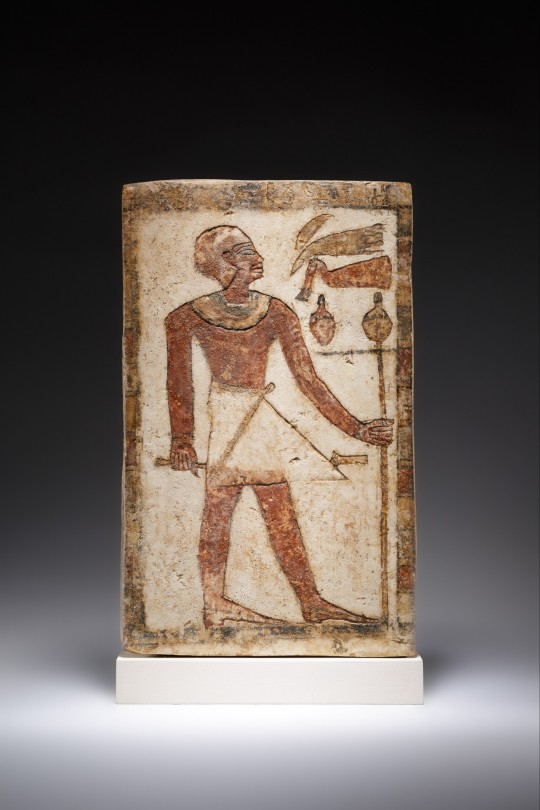
~ Stela of a Man.
Period: Middle Kingdom, 11th Dynasty
Date: ca. 2030–1981 B.C.
Place oforigin: Egypt, Upper Egypt, Thebes, Deir el-Bahri, Cemetery 100, Tomb TT 114, MMA excavations, 1926–27
Medium: Limestone, paint
#ancient#ancient art#history#museum#archeology#ancient egypt#ancient sculpture#ancient history#archaeology#egyptian#egyptology#Egypt#stela of a man#11th Dynasty#middle kingdom#thebes#ca. 2030 b.c.#ca. 1981 b.c.
636 notes
·
View notes
Text


Lintel of Amenemhat I and Deities
Metropolitan Museum of Art, Egyptian Art Collection
On view at The Met Fifth Avenue in Gallery 108
Period: Middle Kingdom
Dynasty: Dynasty 12
Reign: reign of Amenemhat I–Senwosret I
Date: ca. 1981–1952 B.C.
Geography: From Egypt, Memphite Region, Lisht North, Pyramid Temple of Amenemhat I, MMA excavations, 1907
Medium: Limestone, paint
Dimensions: H. 36.8 × W. 172.7 × D. 13.3 cm, 183.7 kg (14 1/2 × 68 × 5 1/4 in., 405 lb.)
Accession Number: 08.200.5
31 notes
·
View notes
Photo
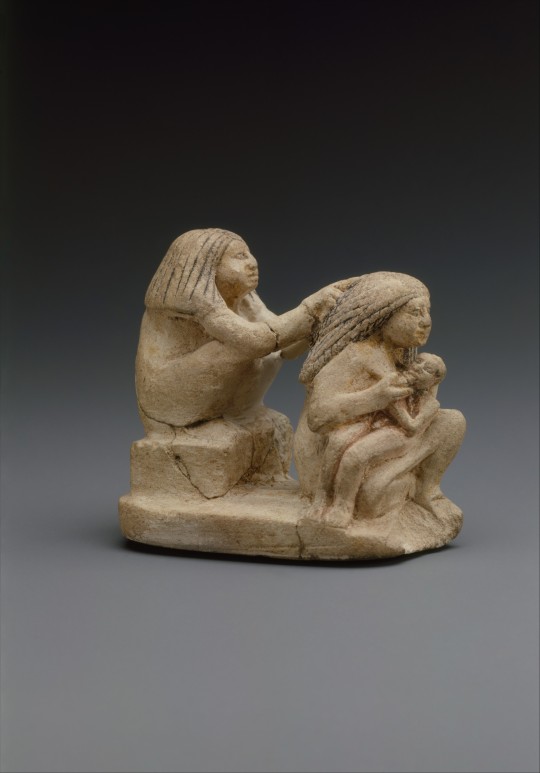


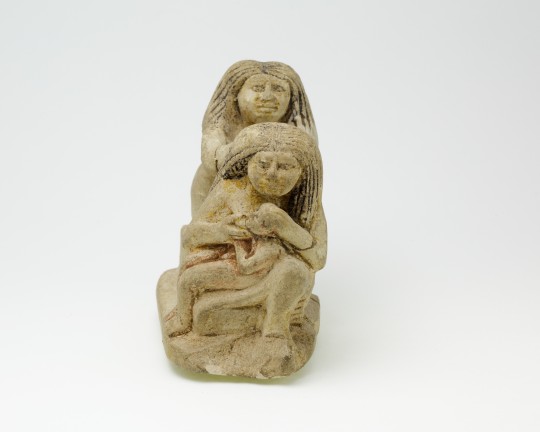
Group of two women and a child,
Middle Kingdom–Early New Kingdom, ca. 1981–1500 B.C.
Limestone, paint
H. 7.1 cm (2 13/16 in.); W. 4.3 cm (1 11/16 in.); L. 8.2 cm (3 1/4 in.)
Courtesy: The Met
#art#design#sculpture#egypt#women#mother's day#child#limestone#paint#middle kingdom#new kingdom#themet#style#history
160 notes
·
View notes
Text

Statuette of man
Middle Kingdom
Dynasty: Dynasty 12–13 Date: ca.
1981–1640 B.c
Medium: Limestone, paint
THE METROPOLITAN MUSEUM
#pharaonices
3 notes
·
View notes
Text





Statuette of Wah - Met Museum Collection
Inventory Number: 20.3.210 Middle Kingdom, Dynasty 12, ca. 1981–1975 B.C. Location Information: From Egypt, Upper Egypt, Thebes, Southern Asasif, Tomb of Wah (MMA 1102), beside feet of mummy, MMA excavations, 1920
Description:
This statuette, intended to serve as a home for Wah's spirit, depicts a young man in the prime of life. Full of vigor, the little figure has the imposing presence of a much larger statue. The linen wrap may imitate the type of long skirt worn by Middle Kingdom officials. Beneath this, the figure wears the more typical short kilt, carved into the wood and painted white.
#Statuette of Wah#middle kingdom#dynasty 12#upper egypt#thebes#southern asasif#asasif#tomb of wah#met museum#20.3.210#mens clothing#MKMC
6 notes
·
View notes
Photo
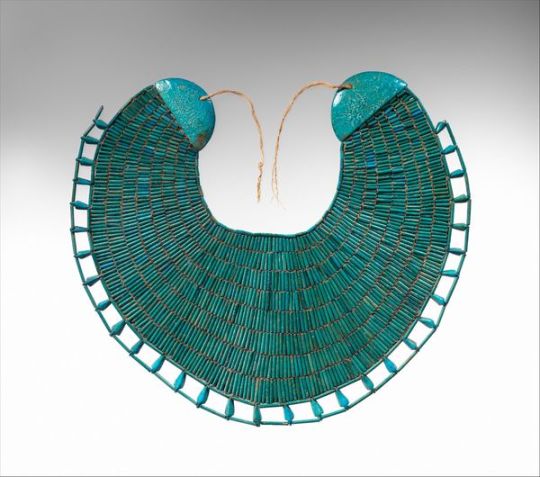
Broad Collar of Wah.
Middle Kingdom, Dynasty 12, reign of Amenemhat I, early,
ca. 1981–1975 B.C. Upper Egypt, Thebes, Southern Asasif, Tomb of Wah (MMA 1102), Mummy, in wrappings on chest, MMA excavations, 1920.
Faience, linen thread.
Dimensions:H. 34.5 cm (13 9/16 in.); W. 39 cm (15 3/8 in.)The Met
22 notes
·
View notes
Text
Ancient Egyptian Rulers
Dynasty 3 ca. 2649–2575 B.C.
Zanakht : ca. 2649–2630 B.C.
Djoser : ca. 2630–2611 B.C.
Sekhemkhet : ca. 2611–2605 B.C.
Khaba : ca. 2605–2599 B.C.
Huni : ca. 2599–2575 B.C.
Dynasty 4 ca. 2575–2465 B.C.
Snefru : ca. 2575–2551 B.C.
Khufu : ca. 2551–2528 B.C.
Djedefre : ca. 2528–2520 B.C.
Khafre : ca. 2520–2494 B.C.
Nebka II : ca. 2494–2490 B.C.
Menkaure : ca. 2490–2472 B.C.
Shepseskaf : ca. 2472–2467 B.C.
Thamphthis : ca. 2467–2465 B.C.
Dynasty 5 ca. 2465–2323 B.C.
Userkaf : ca. 2465–2458 B.C.
Sahure : ca. 2458–2446 B.C.
Neferirkare : ca. 2446–2438 B.C.
Shepseskare : ca. 2438–2431 B.C.
Neferefre : ca. 2431–2420 B.C.
Niuserre : ca. 2420–2389 B.C.
Menkauhor : ca. 2389–2381 B.C.
Isesi : ca. 2381–2353 B.C.
Unis : ca. 2353–2323 B.C.
Dynasty 6 ca. 2323–2150 B.C.
Teti : ca. 2323–2291 B.C.
Userkare : ca. 2291–2289 B.C.
Pepi I : ca. 2289–2255 B.C.
Merenre I : ca. 2255–2246 B.C.
Pepi II : ca. 2246–2152 B.C.
Merenre II : ca. 2152–2152 B.C.
Netjerkare Siptah : ca. 2152–2150 B.C.
First Intermediate Period : ca. 2150–2030 B.C.
Dynasty 8–Dynasty 10 ca. 2150–2030 B.C.
Dynasty 11 (first half)
Mentuhotep I : ca. 2124–2120 B.C.
Intef I : ca. 2120–2108 B.C.
Intef II : ca. 2108–2059 B.C.
Intef III : ca. 2059–2051 B.C.
Mentuhotep II : ca. 2051–2030 B.C.
Middle Kingdom : ca. 2030–1640 B.C.
Dynasty 11 (second half) ca. 2030–1981 B.C.
Mentuhotep II (cont.) : ca. 2030–2000 B.C.
Mentuhotep III : ca. 2000–1988 B.C.
Qakare Intef : ca. 1985 B.C.
Sekhentibre : ca. 1985 B.C.
Menekhkare : ca. 1985 B.C.
Mentuhotep IV : ca. 1988–1981 B.C.
Dynasty 12 ca. 1981–1802 B.C.
Amenemhat I : ca. 1981–1952 B.C.
Senwosret I : ca. 1961–1917 B.C.
Amenemhat II : ca. 1919–1885 B.C.
Senwosret II : ca. 1887–1878 B.C.
Senwosret III : ca. 1878–1840 B.C.
Amenemhat III : ca. 1859–1813 B.C.
Amenemhat IV : ca. 1814–1805 B.C.
Nefrusobek : ca. 1805–1802 B.C.
Dynasty 13 ca. 1802–1640 B.C.
Second Intermediate Period : ca. 1640–1540 B.C.
Dynasty 14–Dynasty 16 ca. 1640–1635 B.C.
Dynasty 17 ca. 1635–1550 B.C.
Tao I : ca. 1560 B.C.
Tao II : ca. 1560 B.C.
Kamose : ca. 1552–1550 B.C.
New Kingdom : ca. 1550–1070 B.C.
Dynasty 18 : ca. 1550–1295 B.C.
Ahmose : ca. 1550–1525 B.C.
Amenhotep I : ca. 1525–1504 B.C.
Thutmose I : ca. 1504–1492 B.C.
Thutmose II : ca. 1492–1479 B.C.
Thutmose III : ca. 1479–1425 B.C.
Hatshepsut (as regent) : ca. 1479–1473 B.C.
Hatshepsut : ca. 1473–1458 B.C.
Amenhotep II : ca. 1427–1400 B.C.
Thutmose IV : ca. 1400–1390 B.C.
Amenhotep III : ca. 1390–1352 B.C.
Amenhotep IV : ca. 1353–1349 B.C.
Akhenaten : ca. 1349–1336 B.C.
Neferneferuaton : ca. 1338–1336 B.C.
Smenkhkare : ca. 1336 B.C.
Tutankhamun : ca. 1336–1327 B.C.
Aya : ca. 1327–1323 B.C.
Haremhab : ca. 1323–1295 B.C.
Dynasty 19 : ca. 1295–1186 B.C.
Ramesses I : ca. 1295–1294 B.C.
Seti I : ca. 1294–1279 B.C.
Ramesses II : ca. 1279–1213 B.C.
Merneptah : ca. 1213–1203 B.C.
Amenmesse : ca. 1203–1200 B.C.
Seti II : ca. 1200–1194 B.C.
Siptah : ca. 1194–1188 B.C.
Tawosret : ca. 1188–1186 B.C.
Dynasty 20 : ca. 1186–1070 B.C.
Sethnakht : ca. 1186–1184 B.C.
Ramesses III : ca. 1184–1153 B.C.
Ramesses IV : ca. 1153–1147 B.C.
Ramesses V : ca. 1147–1143 B.C.
Ramesses VI : ca. 1143–1136 B.C.
Ramesses VII : ca. 1136–1129 B.C.
Ramesses VIII : ca. 1129–1126 B.C.
Ramesses IX : ca. 1126–1108 B.C.
Ramesses X : ca. 1108–1099 B.C.
Ramesses XI : ca. 1099–1070 B.C.
Hight Priests (HP) of Amun : ca. 1080–1070 B.C.
HP Herihor : ca. 1080–1074 B.C.
HP Paiankh : ca. 1074–1070 B.C.
Third Intermediate Period ca. 1070–713 B.C.
Dynasty 21 ca. 1070–945 B.C.
Smendes : ca. 1070–1044 B.C.
HP Painedjem I : ca. 1070–1032 B.C.
HP Masaharta : ca. 1054–1046 B.C.
HP Djedkhonsefankh : ca. 1046–1045 B.C.
HP Menkheperre : ca. 1045–992 B.C.
Amenemnisu : ca. 1044–1040 B.C.
Psusennes I : ca. 1040–992 B.C.
Amenemope : ca. 993–984 B.C.
HP Smendes : ca. 992–990 B.C.
HP Painedjem II : ca. 990–969 B.C.
Osochor : ca. 984–978 B.C.
Siamun : ca. 978–959 B.C.
HP Psusennes : ca. 969–959 B.C.
Psusennes II : ca. 959–945 B.C.
Dynasty 22 (Libyan) ca. 945–712 B.C.
Sheshonq I : ca. 945–924 B.C.
Osorkon I : ca. 924–889 B.C.
Sheshonq II : ca. 890 B.C.
Takelot I : ca. 889–874 B.C.
Osorkon II : ca. 874–850 B.C.
Harsiese : ca. 865 B.C.
Takelot II : ca. 850–825 B.C.
Sheshonq III : ca. 825–773 B.C.
Pami : ca. 773–767 B.C.
Sheshonq V : ca. 767–730 B.C.
Osorkon IV : ca. 730–712 B.C.
Dynasty 23 ca. 818–713 B.C.
Pedubaste I : ca. 818–793 B.C.
Iuput I : ca. 800 B.C.
Sheshonq IV : ca. 793–787 B.C.
Osorkon III : ca. 787–759 B.C.
Takelot III : ca. 764–757 B.C.
Rudamun : ca. 757–754 B.C.
Iuput II : ca. 754–712 B.C.
Peftjaubast : ca. 740–725 B.C.
Namlot : ca. 740 B.C.
Thutemhat : ca. 720 B.C.
Dynasty 24 ca. 724–712 B.C.
Tefnakht : ca. 724–717 B.C.
Bakenrenef : ca. 717–712 B.C.
Late Period : ca. 712–332 B.C.
Dynasty 25 (Nubian) ca. 712–664 B.C.
Piye (establishes Nubian Dynasty in Egypt) : ca. 743–712 B.C.
Shabaqo : ca. 712–698 B.C.
Shebitqo : ca. 698–690 B.C.
Taharqo (loses control of Lower Egypt) : ca. 690–664 B.C.
Tanutamani (loses control of Upper Egypt) : ca. 664–653 B.C.
Dynasty 26 (Saite) 688–525 B.C.
Nikauba : 688–672 B.C.
Necho I : 672–664 B.C.
Psamtik I : 664–610 B.C.
Necho II : 610–595 B.C.
Psamtik II : 595–589 B.C.
Apries : 589–570 B.C.
Amasis : 570–526 B.C.
Psamtik III : 526–525 B.C.
Dynasty 27 (Persian) 525–404 B.C.
Cambyses : 525–522 B.C.
Darius I : 521–486 B.C.
Xerxes I : 486–466 B.C.
Artaxerxes I : 465–424 B.C.
Darius II : 424–404 B.C.
Dynasty 28 522–399 B.C.
Pedubaste III : 522–520 B.C.
Psamtik IV : ca. 470 B.C.
Inaros : ca. 460 B.C.
Amyrtaios I : ca. 460 B.C.
Thannyros : ca. 445 B.C.
Pausiris : ca. 445 B.C.
Psamtik V : ca. 445 B.C.
Psamtik VI : ca. 400 B.C.
Amyrtaios II : 404–399 B.C.
Dynasty 29 399–380 B.C.
Nepherites I: 399–393 B.C.
Psammuthis : 393 B.C.
Achoris : 393–380 B.C.
Nepherites II : 380 B.C.
Dynasty 30 380–343 B.C.
Nectanebo I : 380–362 B.C.
Teos : 365–360 B.C.
Nectanebo II : 360–343 B.C.
Persians : 343–332 B.C.
Khabebesh : 343–332 B.C.
Artaxerxes III Ochus : 343–338 B.C.
Arses : 338–336 B.C.
Darius III Codoman : 335–332 B.C.
Macedonian Period 332–304 B.C.
Alexander the Great : 332–323 B.C.
Philip Arrhidaeus : 323–316 B.C.
Alexander IV : 316–304 B.C.
Ptolemaic Period 304–30 B.C.
Ptolemy I Soter I : 304–284 B.C.
Ptolemy II Philadelphos : 285–246 B.C.
Arsinoe II : 278–270 B.C.
Ptolemy III Euergetes I : 246–221 B.C.
Berenike II : 246–221 B.C.
Ptolemy IV Philopator : 222–205 B.C.
Ptolemy V Epiphanes : 205–180 B.C.
Harwennefer : 205–199 B.C.
Ankhwennefer : 199–186 B.C.
Cleopatra I : 194–176 B.C.
Ptolemy VI Philometor : 180–145 B.C.
Cleopatra II : 175–115 B.C.
Ptolemy VIII Euergetes II : 170–116 B.C.
Harsiese : ca. 130 B.C.
Ptolemy VII Neos Philopator : 145–144 B.C.
Ptolemy IX Soter II : 116–80 B.C.
1 note
·
View note
Text


Statuette of Merer
Middle Kingdom ca. 1981–1802 B.C.
On view at The Met Fifth Avenue in Gallery 112
The four statues 10.176.57-.60 belonged to the Scribe of Divine Offerings Merer. Their short kilts are covered with spells from the Coffin Texts. The phrase inscribed on the two middle-sized figures (.58 and .60) is typical: "Oh Osiris Merer, come with me and I will open for you your eyes that they may lead you on the ways of darkness and that they may put fear of you into the Imperishable Ones, as did Horus for his father Osiris."
1 note
·
View note
Photo
Model Cattle stable from the tomb of Meketre
Middle Kingdom, Dynasty 12, early reign of Amenemhat I, ca. 1981–1975 B.C.
From Egypt, Upper Egypt, Thebes, Southern Asasif, Tomb of Meketre (TT 280, MMA 1101), MMA excavations, 1920
Plastered and painted wood, gesso
Dimensions: l. 72.5 cm (28 9/16 in); w. 57 cm (22 7/16 in); h. 28.5 cm (11 1/4 in) average height of cattle: 18 cm (7 1/16 in.)
This model of a stable was found with twenty three other models of boats, gardens, and workshops in a hidden chamber at the side of the passage leading into the rock cut tomb of the royal chief steward Meketre, who began his career under King Nebhepetre Mentuhotep II of Dynasty 11 and continued to serve successive kings into the early years of Dynasty 12. Cattle are being fattened for slaughter in this stable. Four oxen feed from a manger in the large stall; two others are being hand fed by the stablemen from a pile of fodder and a sack of grain in the room in front. One of the cattle is so fat he can no longer stand. By the door sits an overseer with a baton in his hand. All the accessible rooms in the tomb of Meketre had been robbed and plundered already during Antiquity; but early in 1920 the Museum's excavator, Herbert Winlock, wanted to obtain an accurate floor plan of the tomb's layout for his map of the Eleventh Dynasty necropolis at Thebes and, therefore, had his workmen clean out the accumulated debris. It was during this cleaning operation that the small hidden chamber was discovered, filled with twenty-four almost perfectly preserved models. Eventually, half of these went to the Egyptian Museum, Cairo, and the other half came to the Metropolitan Museum in the partition of finds. Collection of the Metropolitan Museum of Art
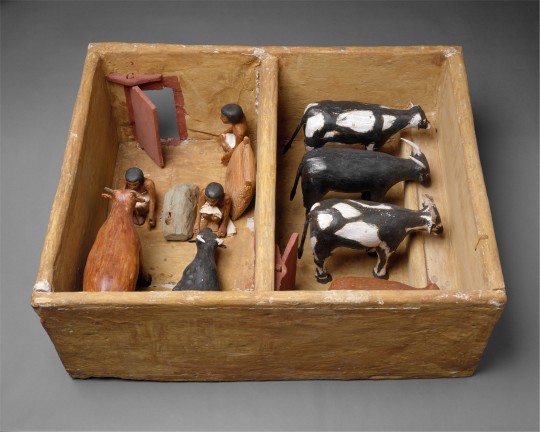
Model cattle stable from the tomb of Meketre, 1981BC-1975BC, Thebes, Egypt.
196 notes
·
View notes
Text
Statue of Nebhepetre Mentuhotep II (detail), (ca. 2030–2000 B.C.)
Mentuhotep dynastic line was quickly extinguished and a new one, Egypt's Twelfth Dynasty, was founded by a capable commoner named Amenemhat I. The Twelfth Dynasty, 1981 –1802 B.C., represented the Middle Kingdom at the zenith of its political power and cultural influence.
An image of a member of that dynasty, Amenemhat III, who ruled ca. 1859–1813 B.C., is the focal point of the entire exhibition. This work testifies to the success of Middle Kingdom artists in rediscovering the skills of the Old Kingdom and then progressing to greater heights of creative accomplishment.
Head of a Statue of Amenemhat III Wearing the White Crown from the collection of the Ny Carlsberg Glyptotek in Copenhagen, Denmark, is an unsurpassed masterpiece even in its severely damaged form. It was sculpted from graywacke, a hard siltstone from quarries near the Red Sea. The Egyptians were master carvers of graywacke as far back as the fabled Narmer Palette, executed in honor of the first pharaoh around 3100 B.C.

0 notes
Photo

String of Egyptian Wedjat Amulets
Period: Middle Kingdom
Dynasty 12–13 Date: ca. 1981–1640 B.C.
40 notes
·
View notes
Text

~ Amulet with ankhs.
Period: Middle Kingdom; 12th-13th Dynasty
Date: ca. 1981–1640 B.C.
Place of origin: Egypt, Memphite Region, Lisht North (Tomb 954, Burial 954L, MMA excavations, 1921–22)
Medium: Quartz, gold
#ancient art#ancient#history#museum#archeology#ancient history#archaeology#egyptology#egypt#egyptian#ancient Egypt#ankh#amulet with ankhs#12th dynasty#13th dynasty#middle kingdom#ca. 1981 b.c.#ca. 1640 b.c.#quartz#gold
1K notes
·
View notes
Text


Model Bakery and Brewery from the Tomb of Meketre
Metropolitan Museum of Art, Egyptian Art Collection
On view at The Met Fifth Avenue in Gallery 105
Period: Middle Kingdom
Dynasty: Dynasty 12
Reign: reign of Amenemhat I, early
Date: ca. 1981–1975 B.C.
Geography: From Egypt, Upper Egypt, Thebes, Southern Asasif, Tomb of Meketre (TT 280, MMA 1101), serdab, MMA excavations, 1920
Medium: Wood, gesso, paint, linen
Dimensions: l. 73 cm (28 3/4 in); w. 55 cm (21 5/8 in); h. 29 cm (11 7/16 in) average height of figures: 21 cm (8 1/4 in.)
Credit Line: Rogers Fund and Edward S. Harkness Gift, 1920
Accession Number: 20.3.12
44 notes
·
View notes
Text
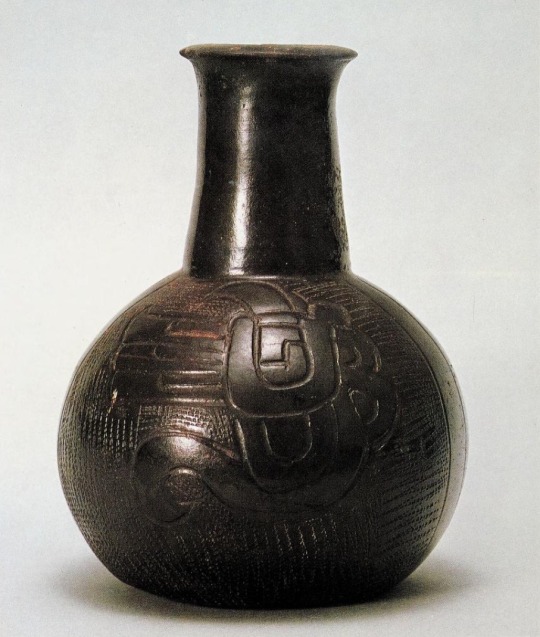
CHAVÍN CULTURE, CUPISNIQUE STYLE
Bottle with incised head ca. 800-500 B.C. Incised and rocker-stamped black ceramic; height 16 cm.
North coast, Chicama Valley Rafael Larco Herrera Museum, Lima.
From: “Museums of the Andes”, 1981. 
8 notes
·
View notes
Photo
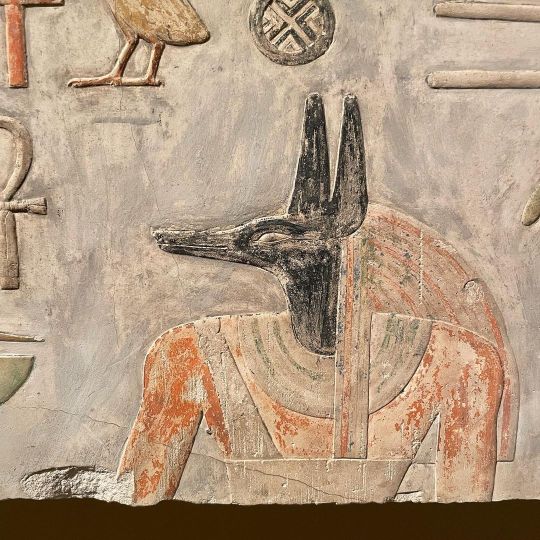
Lintel of Amenemhat I and Deities (ca. 1981–1952 B.C.) | Middle Kingdom In this relief Amenemhat I (𓇋𓏠𓈖𓅓𓄂𓏏) “ı͗mn-m-ḥ3.ṯ”“Amun is in Front” is shown celebrating his thirty-year 𓎈𓆴 jubilee (Sed Festival) 𓋴𓂧𓈅𓉳𓎳 “h(A)b-sd”, ritually demonstrating that he was still vigorous and fit to rule 𓋾𓏘𓄿𓀭 “ḥq3”. The king 𓇓𓈖𓏏 “nsw” is flanked by the jackal-headed god Anubis 𓇋𓈖𓊪𓅱𓃣 “inpw” and the falcon-headed Horus 𓅃 “ḥrw”, deities 𓊹𓊹𓊹 “nṯrw” closely associated with coronation rituals; each god offers him an ankh 𓋹𓈖𓐍 “ˁnḫ” the hieroglyph 𓌃𓂧𓅱𓀁𓊹 “mdw-nṯr” (divine writing) for life. To the left stands Nekhbet 𓇑𓃀𓏌𓏏𓅐 “nḫb.t”, patron goddess of Upper Egypt 𓇾𓇙 “t3-šmˁ” (the south), and on the right is Wadjet 𓇆𓇌𓏏𓐎𓆗 “wAḏ.yt”. of Lower Egypt 𓇾𓇊 “t3-mḥw” (the north), creating a symmetrical composition that evokes the unified land 𓇾 “t3”. The king wears a tightly curled wig, with an uraeus-cobra 𓅜𓏏𓆘 “3ḫ.t” on his brow to protect 𓎂 or 𓎃 “s3” him from his enemies 𓐍𓆑𓏏𓏭𓀏 “ḫfty” and the false beard of kingship. He carries a flail 𓈖𓐍𓐍𓌅 “nḫ3ḫ3”, also a symbol of his rule, and a ceremonial instrument known as a mekes. Period: Middle Kingdom Dynasty: Dynasty 12 Reign: reign of Amenemhat I–Senwosret I Date: ca. 1981–1952 B.C. Geography: From Egypt, Memphite Region, Lisht North, Pyramid Temple of Amenemhat I, MMA excavations, 1907 Medium: Limestone, paint Dimensions: H. 36.8 cm (14 1/2 in.); W. 172.7 cm (68 in.); D. 13.3 cm (5 1/4 in.) 𓋹𓎬𓋹𓎬𓋹𓎬𓋹𓎬𓋹𓎬𓋹𓎬𓋹𓎬𓋹𓎬𓋹𓎬𓋹𓎬𓋹𓎬𓋹𓎬𓋹𓎬𓋹𓎬𓋹𓎬𓋹𓎬 📸 @egyptologylessons © 𓋹𓊽𓋴𓆖𓎛𓇳𓎛 (@metmuseum and description) 𓊁𓊁𓊁𓊁𓊁𓊁𓊁𓊁𓊁𓊁𓊁𓊁𓊁𓊁𓊁𓊁𓊁 #Ancienthistory #historyfacts #historylovers #ancientegypt #hieroglyphics #ägypten #egyptologist #egyptianhistory #egyptology #hieroglyphs #egypte #egyptians #egitto #埃及 #مصر #egipto #이집트 #art #culture #history #lintel #amenemhat #metropolitanmuseumofart #anubis #horus https://www.instagram.com/p/CafWm9IOY4n/?utm_medium=tumblr
#ancienthistory#historyfacts#historylovers#ancientegypt#hieroglyphics#ägypten#egyptologist#egyptianhistory#egyptology#hieroglyphs#egypte#egyptians#egitto#埃及#مصر#egipto#이집트#art#culture#history#lintel#amenemhat#metropolitanmuseumofart#anubis#horus
11 notes
·
View notes
Text

Bracelet of cylindrical beads - Met Museum Collection
Inventory Number: 24.1.34 Middle Kingdom, Dynasty 12, ca. 1981–1802 B.C. Location Information: From Egypt, Memphite Region, Lisht South, tomb of Sehetepibreankh, Pit 6L.P17, MMA excavations, 1923–24
#Bracelet of cylindrical beads#bracelet#bracelets#jewelry#middle kingdom#dynasty 12#lower egypt#memphite region#lisht#lisht south#tomb of Sehetepibreankh#met museum#24.1.34#MKJ
4 notes
·
View notes